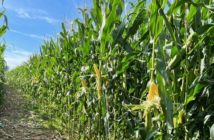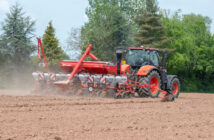The importance of early maturing varieties and total plant digestibility was stressed at a maize open day in Bangor on Dee where farmers got the opportunity to see the latest developments and test their forage maize for feed quality ahead of harvest.
Wynnstay invited some of their growers to hear an update from Limagrain on modern maize varieties, and the impact they’re having on the bottom line for dairy farmers.
Dr Simon Pope, Wynnstay Crop Protection Manager said that a stark comparison carried out by Limagrain of improvements in variety performance from 1992 to 2016* showed that there has been a highly significant 45% increase in milk yield per hectare*.
“This can be attributed solely to the major advances in maize breeding resulting in today’s modern varieties.
“It was great to see some of the 6,000 trial plots on display at the site, and hear about the latest in modern sampling technology associated with maize research. We had the opportunity to see first-hand the NIRS machine (near infrared reflectance spectroscopy) and sample maize plants brought by our farmers.
“The NIRS machine is very impressive to see in action. It takes the sample from a chopped whole plant, and provides an instant, accurate forage analysis of the maize crop, demonstrating accurate Dry Matter (DM) along with other key stats, such as starch %, total cell wall digestibility (CWD) and digestible fibre (DNDF),” said Dr Pope.
“It takes the guess work out of knowing when a crop is ready to harvest and has been a major step forward in variety trial work.
“The maize harvest is already underway in some places. The NIRS results we saw, and crop walking with our farmers, confirms that some early varieties are now bang on the target 32% DM and more than 30% starch.
“However, there is still a noticeable range in maturity, and for every crop that looks fit to harvest there are an equal number of later varieties which are still a way off. The results from the samples taken on the day confirmed exact harvest dates for farmers on a bespoke, farm-by-farm basis.”
Dr Pope added that, seeing the results from the NIRS test also helped to explain why performance indicators of a maize crop, such as DM shouldn’t be viewed in isolation.
“CWD and DNDF are also important as they provide unit measurements for how the whole crop will feed. This is where new varieties are really coming into their own.
“There is no variety on the NIAB list with an earlier maturity than the Limagrain variety Reason which can match its DM yield. But it’s only when you look at the outstanding ME yield/ha, which combines both starch yield and total plant digestibility, that you see why it is such a strong contender for 2017.
“In both favourable and unfavourable areas, Reason is proving to be a first choice variety with early vigour that is delivering across the board.
“Following what has been the ideal growing season for maize, the next hurdle is to get crops in at the right time, and harvested in good condition at the target DM of 32% to guarantee a quality feed source, but growers should be feeling positive.”



